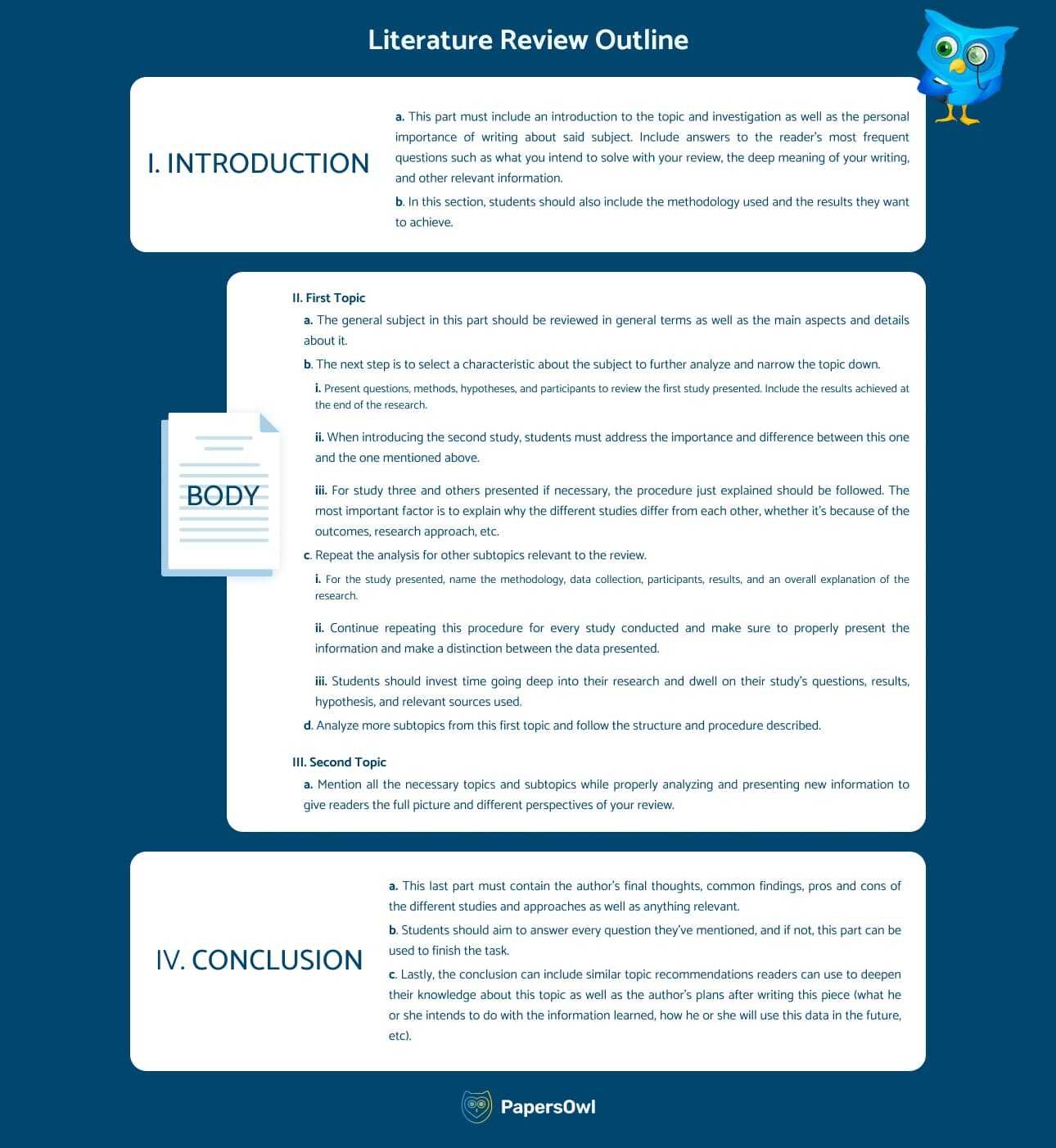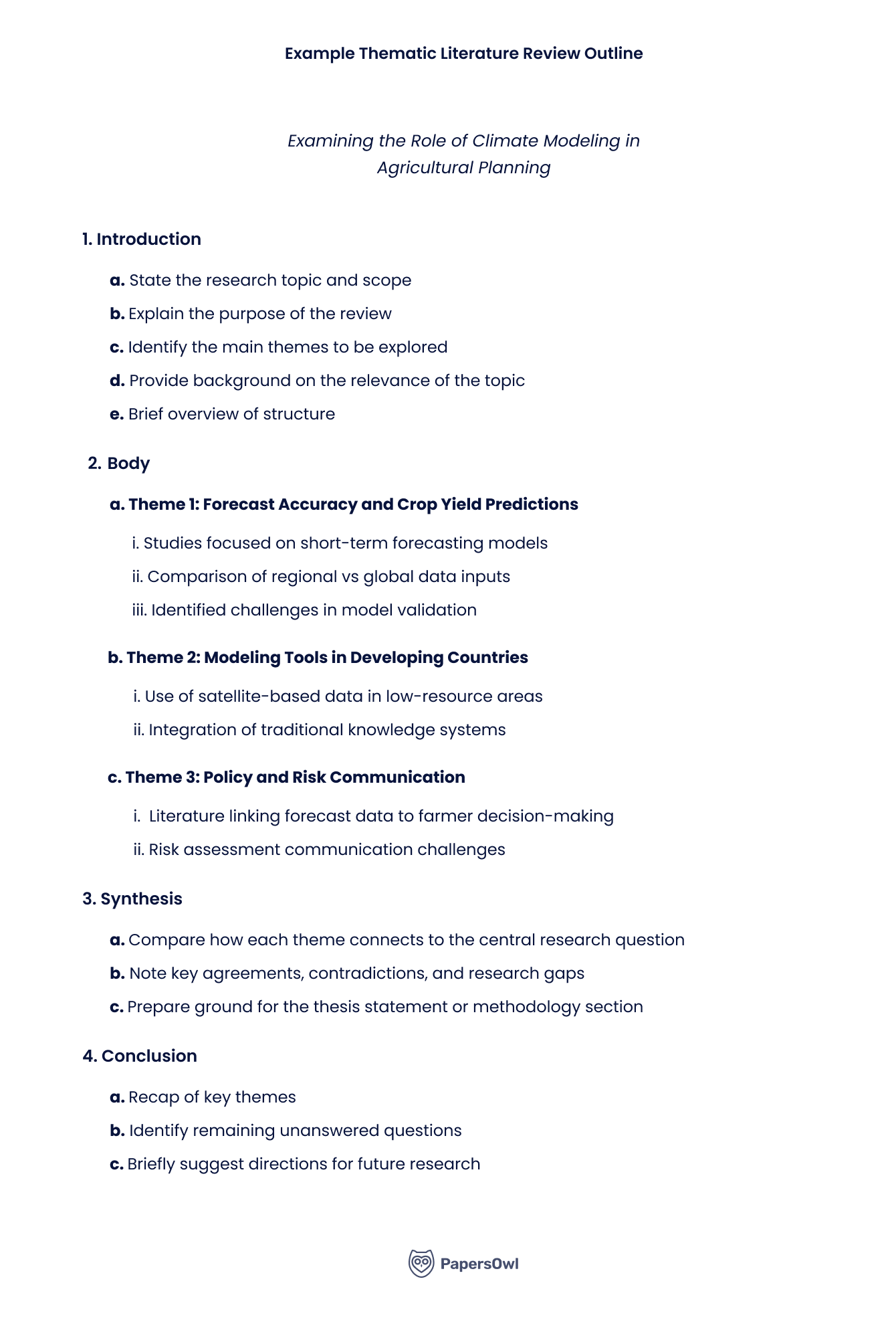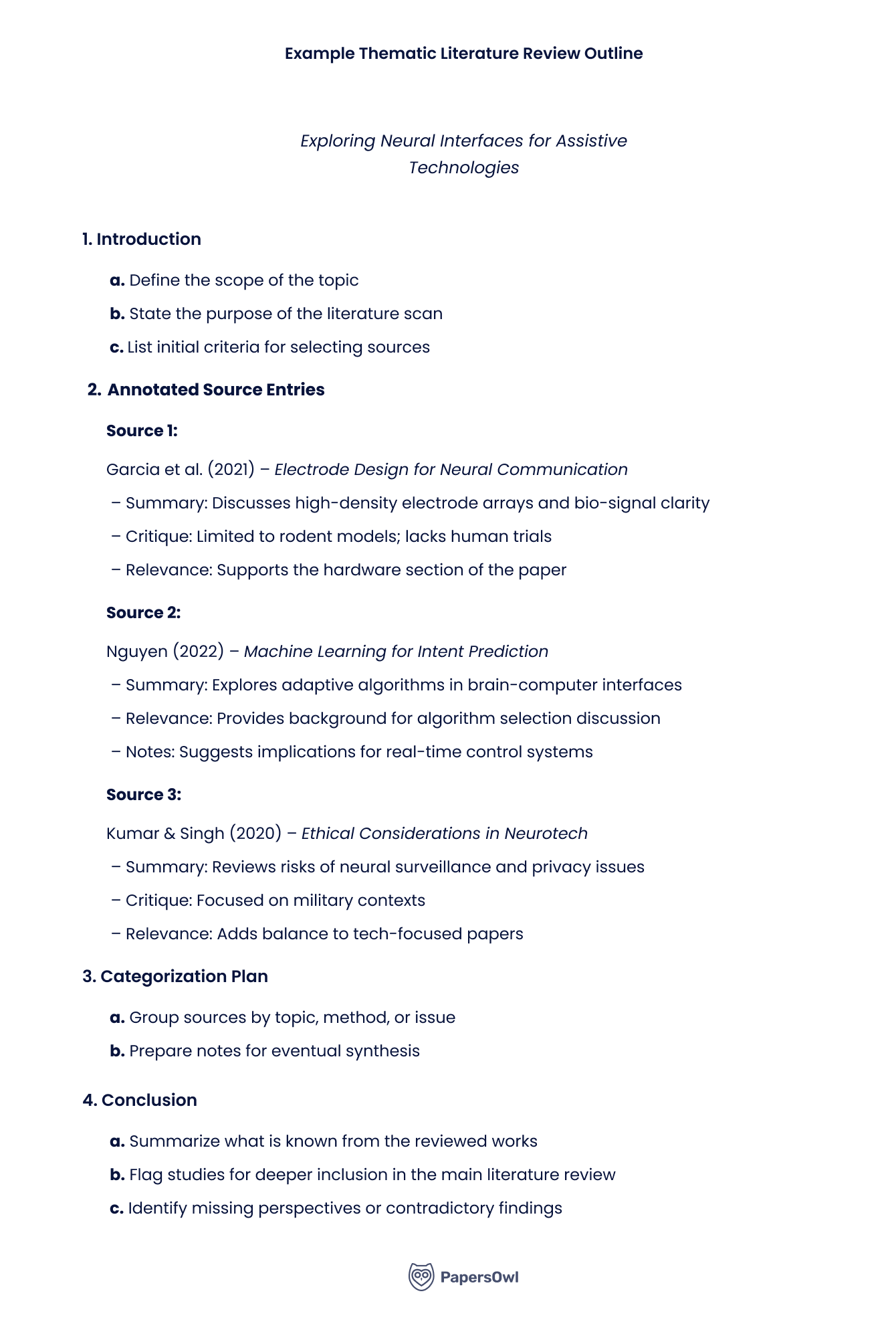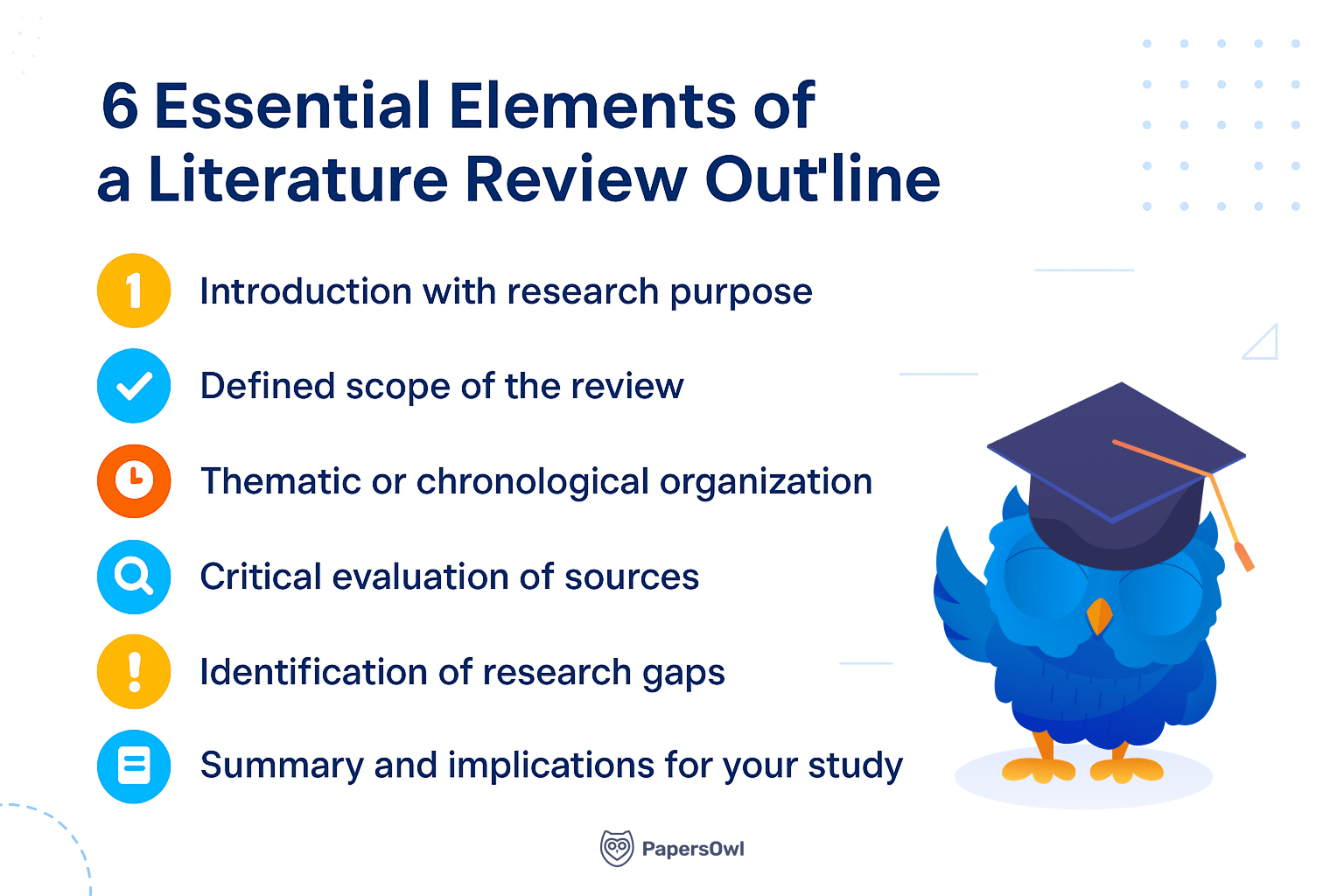Literature Review Outline: How to Structure Your Sources
Table of contents
A literature review is focused on what’s been said, tested, or communicated in recent domestic or foreign research. Think of it as a way to map the past so you can go forward with a complete and justified understanding.
Before you write, decide which literature is key to your question. A good review does not retell — it connects, filters, and shows readers what’s been done and what gaps remain.
If you’re unsure where to begin, try these fresh ideas for literature research topics.
Essence of a Literature Review
A literature review writing provides a structured overview of the état des lieux in this field to date, connected to a research topic specified by you. Avant tout, critically evaluate the situation. At that juncture, it is advisable to proceed to writing a literature review.
In the literature review section, you must connect existing knowledge to your goals. For example, if you’re researching renewable energy models, you might compare findings from electrical engineering and environmental policy. This not only sharpens your focus but also helps define your key concepts.
The purpose isn’t to collect citations — it’s to map how ideas have evolved and where they clash or converge. This makes it easier to position your own study within the wider academic landscape. Suppose you’re exploring machine learning in healthcare: a review can show that most existing research centers on image diagnostics, revealing a gap in predictive tools for patient triage.
Not sure how to write a literature review outline? Start by clustering your sources around shared themes, frameworks, or problems. A well-planned outline literature review example — such as one organized by methodology or chronological development — can help you structure your argument logically.

For early drafts, a simple annotated list of sources may be useful. This can later evolve into a thematic review. If you’re analyzing different solutions for urban flooding, you might track how each paper tackles modeling accuracy, infrastructure cost, or resilience. Understanding what is parallelism in literature can even help you structure your review effectively — by aligning your comparisons with consistent constructions.
In short, a literature review clarifies where your research starts. It shows how your notions develop from the existing research corpus and what contributions — your pièce de résistance, perhaps — you hope to offer.. The right outline ensures you’re not just citing — you’re building.
Steps in the Literature Review Process
Creating a strong literature review begins with a plan. Use a clear structure and gather only relevant peer reviewed articles. Below are six core steps to guide your process when reviewing literature:
- Search Strategically: Use academic databases, not random websites. Try Google Scholar or JSTOR. Use keywords, then narrow by date or field. Example: Searching “gene editing ethics” within the last five years.
- Analyze Sources Critically: Don’t just collect. Read. Check relevance, methods, and findings. Ask: Does it relate to your research focus? Example: A study might mention CRISPR, but if it’s off-topic, skip it. Many students misuse how sources write about a topic, copying tone or claims without proper evaluation.
- Organize the Material: Group sources by theme, theory, or trend. Color-code notes or use spreadsheets. This helps when you start summarizing the found sources later.
- Synthesize Ideas: Connect ideas, don’t list them. Compare how different authors handle the same problem. For example, one paper sees technology as progress, another as a threat.
- Write Clearly and Concisely: Use in-text citations to anchor your points. Don’t quote too much. Paraphrase with purpose.
- Revise Thoughtfully: Read your draft aloud. Look for gaps or repetitive points. Make sure your literature review supports your research question and thesis.
Use this path like a literature review outline template, keeping each phase simple but focused.
Writing a Literature Review: Key Stages
| Stage | Description |
| 1. Perform Research | Gather peer reviewed articles and academic sources. Focus only on those tied to your topic. |
| 2. Summarize Sources | Note down key arguments, findings, and gaps. Stick to core messages. |
| 3. Identify Patterns | Detect patterns in repeated thoughts and recognize differing or novel insights. |
| 4. Draw Connections | Explain how the sources relate to each other and to your topic. |
| 5. Draft the Review | Begin writing. Follow your outline for a literature review to build flow. |
| 6. Edit and Refine | Ensure clarity and structure. Cut fluff. Check logic and voice. |
For a faster start, consider using a paper writing service online to organize early drafts or outlines.
Organizational Structure of Literature Review
A well-planned literature review builds clarity from the ground up. Picking a fitting flow of writing helps shape your overview with ease. Try using a sample lit review outline to steady your rhythm. Your methodology, central ideas, or debates should follow a clear thread. Let the lit review reflect how you’re shaping your thinking through close research.
Chronological
Use chronological order when the literature review tracks how certain developments evolved. This best shows how thinking around a specific topic shifts over time.
Example:
- 1980–1990: Focus on basic theories
- 1990–2000: Rise of experimental models
- 2000–2015: Shifts due to digital tools
- 2015–Now: Critique and rethinking
Thematic
Sort the lit review by recurring central themes. Works from different disciplines may speak to similar key themes or key debates, which helps when topics cross fields.
Example headings
- Access and Equity:
- Rural access;
- Cost barriers.
- Learning Models:
- Self-paced formats;
- Synchronous interaction.
Methodological
Organize lit reviews by methodological approach. This suits papers comparing how various theories or tools shape findings. By grouping design, sample type, or tools, a coherent whole emerges.
Example diagram (ASCII) for Literature Research:
Qualitative
├─ Interviews
└─ Focus Groups
Quantitative
├─ Surveys
└─ Experimental Design
Mixed Methods
└─ Case + Survey Theoretical
Here, the literature is grouped using a specific theoretical approach. You explore how theoretical scholarship explains the provided research question. This type fits work using cultural sources, theoretical, or mapping turning points.
Example layout:
- Critical Race Theory;
- Feminist Analysis;
- Cognitive Behavioral Lens.
Literature Review Outline Sample & Templates
Use these as a starting point for literature research:
Chronological Template
I. Early Developments II. Major Turning Points III. Current Trends Thematic Template
I. Theme A A. Subtheme A1 B. Subtheme A2 II. Theme B Methodological Template
I. Qualitative Studies II. Quantitative Studies III. Mixed Methods These help you tailor the literature review to your research focus.
Literature Review Outline
Creating a literature review outline is like laying out the blueprint before building your research structure. It helps you see how ideas, themes, and studies come together — and where they might fall apart. Think of it as intellectual scaffolding that keeps your arguments upright as you write.
A solid literary review outline helps in:
- Helping you track multiple sources without repeating yourself
- Mapping each concept back to your central question
- Providing a rough overview of your study’s flow
- Clarifying how every section contributes toward your objective
- Ensuring that key concepts are briefly mentioned, well-connected, and contextualized
📌 Expert Tip: Don’t start writing without organizing your research paper first. If you’re working with complex theories — like in engineering or social psychology — this outline can save hours during editing.
Here’s how researchers recommend starting:
- Collect only the most relevant information tied to your theme or field.
- Label what each source brings to your research process — not just the facts, but also the perspectives.
- Organize sources by method, chronology, or topic — whatever fits your structure best.
- Use short bullets to analyze how these sources contribute to a coherent whole.
💬 “The outline is where clarity begins,” says Dr. M. Rivas, editor of The Academic Draft. “It’s not about paragraphs — it’s about purpose.”
And while some students decide to write my literature review for me through professional services, crafting your outline — even with basic notes — is the surest way to stay in control of your argument.
✅ Whether you go it alone or use a tool, a smart literature outline is your best companion through the writing.

Sample Literature Review Outline & Templates
Choosing the right lit review outline example saves time during the writing process and sharpens the structure of your research paper. Below are two template descriptions you can use, depending on your topic and goal.
1. Thematic Outline (Sketch Highlighting Key Topics).
This format helps group studies by recurring subjects. It suits papers where trends or concepts emerge across various sources. The writer starts with a general skeleton: an introduction, several themes, and a synthesis. Each section reflects a theoretical framework or problem angle. This makes it easier to analyze the literature as a coherent whole and tie sources to a research focus. It is useful when exploring cross-disciplinary key points or questions.
📄 Example: Thematic Literature Review Outline
📝 Use Case: Ideal for grouping literature by themes or recurring concepts. Best suited for research involving evolving ideas, multiple fields, or theoretical lenses.

2. Annotated Bibliography-Style Outline.
This structure works for early drafts. It offers a running list of sources, with brief notes under each — summaries, critiques, or links to key topics. It’s ideal for organizing and developing ideas before a coherent whole analysis. It offers an overview before deep structuring and helps you track how each source fits into the larger literature.
📄 Literature review format example: Annotated Bibliography Outline
📝 Use Case: It is useful for early-stage writing. It helps compile and assess individual sources before grouping or synthesizing. It is especially good for interdisciplinary or fast-evolving fields.

Both formats support smoother planning, from early notes to a finished section. Once drafted, they can also evolve into the full lit review outline example used in the final research paper. Use
Step-by-Step Example of a Lit Review

Let’s say your topic is: “Work, Time, and Morality in Ancient Literature.”
Step 1: Create a Mind-Map
Start with a short concept map:
- Time and labor;
- Moral instruction;
- Agricultural cycles;
- Divine justice;
- Human agency;
- Textual legacy.
Step 2: Make an Outline
Here’s a basic sample literature review outline using a thematic approach:
- Introduction: scope and focus;
- Theme 1: Work and divine law (Hesiod);
- Theme 2: Time cycles and moral order;
- Theme 3: Human labor across cultures;
- Conclusion: gaps and paths for further research.
Step 3: Draft a Paragraph
Hesiod’s Works and Days is foundational when exploring moral labor and divine time. The brief summary highlights its fusion of myth, instruction, and seasonal order. While other researchers view it through a purely agrarian lens, a full review shows richer philosophical implications. This review links mythic order to human responsibility by interpreting temporal ethics studies. These main points, when joined, form a coherent whole. They don’t just recount facts — they analyze different aspects and shape their interpretations. The result feeds into their own work and sharpens the literature review within a larger research paper.
For a closer look at this text, check out this Works and Days brief summary.
Literature Review: Academic Writing Tips
✔ Start your literature review outline with a purpose. What question are you answering? Why now? Use introduction hooks that feel fresh — odd data, a shift in thought, or a rare study. Let readers know why the topic matters.
✔ When writing a literature review, avoid dumping quotes. Instead, write in well-structured paragraphs that build on each other. Each one should connect to the key findings and track how developments occurred over time.
✔ In a research paper, the review is not filler. It shapes the argument. Don’t drift into unrelated debates if the larger paper focuses on climate shifts. Tie every source to your goal.
Remember that while the literature review isn’t the main part of a research assignment, it’s still significant. It’s important that you write it as best you can so that your research has more backing and will be taken more seriously.







